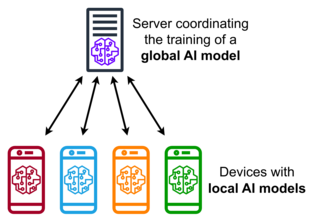Related Research Articles

The client–server model is a distributed application structure that partitions tasks or workloads between the providers of a resource or service, called servers, and service requesters, called clients. Often clients and servers communicate over a computer network on separate hardware, but both client and server may reside in the same system. A server host runs one or more server programs, which share their resources with clients. A client usually does not share any of its resources, but it requests content or service from a server. Clients, therefore, initiate communication sessions with servers, which await incoming requests. Examples of computer applications that use the client–server model are email, network printing, and the World Wide Web.
A distributed system is a system whose components are located on different networked computers, which communicate and coordinate their actions by passing messages to one another. Distributed computing is a field of computer science that studies distributed systems.

Peer-to-peer (P2P) computing or networking is a distributed application architecture that partitions tasks or workloads between peers. Peers are equally privileged, equipotent participants in the network. This forms a peer-to-peer network of nodes.

In computer networking, a thin client is a simple (low-performance) computer that has been optimized for establishing a remote connection with a server-based computing environment. They are sometimes known as network computers, or in their simplest form as zero clients. The server does most of the work, which can include launching software programs, performing calculations, and storing data. This contrasts with a rich client or a conventional personal computer; the former is also intended for working in a client–server model but has significant local processing power, while the latter aims to perform its function mostly locally.

A distributed hash table (DHT) is a distributed system that provides a lookup service similar to a hash table. Key–value pairs are stored in a DHT, and any participating node can efficiently retrieve the value associated with a given key. The main advantage of a DHT is that nodes can be added or removed with minimum work around re-distributing keys. Keys are unique identifiers which map to particular values, which in turn can be anything from addresses, to documents, to arbitrary data. Responsibility for maintaining the mapping from keys to values is distributed among the nodes, in such a way that a change in the set of participants causes a minimal amount of disruption. This allows a DHT to scale to extremely large numbers of nodes and to handle continual node arrivals, departures, and failures.
An anonymous P2P communication system is a peer-to-peer distributed application in which the nodes, which are used to share resources, or participants are anonymous or pseudonymous. Anonymity of participants is usually achieved by special routing overlay networks that hide the physical location of each node from other participants.

A wireless mesh network (WMN) is a communications network made up of radio nodes organized in a mesh topology. It can also be a form of wireless ad hoc network.
Content-addressable storage (CAS), also referred to as content-addressed storage or fixed-content storage, is a way to store information so it can be retrieved based on its content, not its name or location. It has been used for high-speed storage and retrieval of fixed content, such as documents stored for compliance with government regulations. Content-addressable storage is similar to content-addressable memory.
Centralized computing is computing done at a central location, using terminals that are attached to a central computer. The computer itself may control all the peripherals directly, or they may be attached via a terminal server. Alternatively, if the terminals have the capability, they may be able to connect to the central computer over the network. The terminals may be text terminals or thin clients, for example.

Edge computing is a distributed computing paradigm that brings computation and data storage closer to the sources of data. This is expected to improve response times and save bandwidth. Edge computing is an architecture rather than a specific technology, and a topology- and location-sensitive form of distributed computing.
Decentralized computing is the allocation of resources, both hardware and software, to each individual workstation, or office location. In contrast, centralized computing exists when the majority of functions are carried out, or obtained from a remote centralized location. Decentralized computing is a trend in modern-day business environments. This is the opposite of centralized computing, which was prevalent during the early days of computers. A decentralized computer system has many benefits over a conventional centralized network. Desktop computers have advanced so rapidly, that their potential performance far exceeds the requirements of most business applications. This results in most desktop computers remaining idle. A decentralized system can use the potential of these systems to maximize efficiency. However, it is debatable whether these networks increase overall effectiveness.
In computing, a shared resource, or network share, is a computer resource made available from one host to other hosts on a computer network. It is a device or piece of information on a computer that can be remotely accessed from another computer transparently as if it were a resource in the local machine. Network sharing is made possible by inter-process communication over the network.

A computer cluster is a set of computers that work together so that they can be viewed as a single system. Unlike grid computers, computer clusters have each node set to perform the same task, controlled and scheduled by software.
A cooperative storage cloud is a decentralized model of networked online storage where data is stored on multiple computers (nodes), hosted by the participants cooperating in the cloud. For the cooperative scheme to be viable, the total storage contributed in aggregate must be at least equal to the amount of storage needed by end users. However, some nodes may contribute less storage and some may contribute more. There may be reward models to compensate the nodes contributing more.
A distributed file system for cloud is a file system that allows many clients to have access to data and supports operations on that data. Each data file may be partitioned into several parts called chunks. Each chunk may be stored on different remote machines, facilitating the parallel execution of applications. Typically, data is stored in files in a hierarchical tree, where the nodes represent directories. There are several ways to share files in a distributed architecture: each solution must be suitable for a certain type of application, depending on how complex the application is. Meanwhile, the security of the system must be ensured. Confidentiality, availability and integrity are the main keys for a secure system.
Cloud load balancing is a type of load balancing that is performed in cloud computing. Cloud load balancing is the process of distributing workloads across multiple computing resources. Cloud load balancing reduces costs associated with document management systems and maximizes availability of resources. It is a type of load balancing and not to be confused with Domain Name System (DNS) load balancing. While DNS load balancing uses software or hardware to perform the function, cloud load balancing uses services offered by various computer network companies.
A blockchain is a distributed ledger with growing lists of records (blocks) that are securely linked together via cryptographic hashes. Each block contains a cryptographic hash of the previous block, a timestamp, and transaction data. Since each block contains information about the previous block, they effectively form a chain, with each additional block linking to the ones before it. Consequently, blockchain transactions are irreversible in that, once they are recorded, the data in any given block cannot be altered retroactively without altering all subsequent blocks.

The InterPlanetary File System (IPFS) is a protocol, hypermedia and file sharing peer-to-peer network for storing and sharing data in a distributed file system. IPFS uses content-addressing to uniquely identify each file in a global namespace connecting IPFS hosts.
A distributed ledger is the consensus of replicated, shared, and synchronized digital data that is geographically spread (distributed) across many sites, countries, or institutions. In contrast to a centralized database, a distributed ledger does not require a central administrator, and consequently does not have a single (central) point-of-failure.

Federated learning is a machine learning technique that trains an algorithm via multiple independent sessions, each using its own dataset. This approach stands in contrast to traditional centralized machine learning techniques where local datasets are merged into one training session, as well as to approaches that assume that local data samples are identically distributed.
References
- 1 2 3 Balda, Braveem (April 2015). "Security Enhancement in Distributed Networking" (PDF). International Journal of Computer Science and Mobile Computing. 4 (4): 761. Retrieved 24 September 2018.
- 1 2 3 4 Srinivasa, K.G.; Muppalla, Anil Kumar (Feb 2015). Guide to High Performance Distributed Computing: Case Studies with Hadoop, Scalding and Spark (Computer Communications and Networks). Springer. pp. 4–8. ISBN 978-3319134963.
- 1 2 3 4 Weija, Jia; Zhou, Wanlei (Dec 2004). Distributed Network Systems: From Concepts to Implementations. Springer. pp. xvii-6. ISBN 978-0387238395.
- ↑ Tsenov, Martin (June 2007). "Example of communication between distributed network systems using web services". Proceedings of the 2007 international conference on Computer systems and technologies - CompSysTech '07. p. 1. doi:10.1145/1330598.1330637. ISBN 9789549641509. S2CID 1873704 . Retrieved 24 September 2018.
- 1 2 Maly, Robin Jan. "Comparison of centralized (client-server) and decentralized (peer-to-peer) networking. Semester thesis" (PDF). ETH Zurich. Retrieved 24 September 2018.
- ↑ Piliouras, Teresa C. (Dec 2004). Network Design, Second Edition: Management and Technical Perspectives (2nd ed.). CRC Press. p. 353. ISBN 9780849316081 . Retrieved 25 September 2018.
- ↑ Mearian, Lucas (31 May 2018). "What is blockchain? The most disruptive tech in decades". Computerworld. Retrieved 24 September 2018.
- ↑ Raval, Siraj. "Chapter 1. What Is a Decentralized Application?". O'Reilly Safari. Retrieved 24 September 2018.
- ↑ "A brave new world: the 1980s home computer boom". History Extra. Retrieved 24 September 2018.
- ↑ Sy, Denh (2011). Anonymous yet traceable wireless mesh networking. California State University. ISBN 978-1-124-40072-3 . Retrieved 25 September 2018.
- ↑ "Distributed Computing: Utilities, Grids & Clouds" (PDF). ITU-T Technology Watch Report. 9. 2009. Retrieved 24 September 2018.